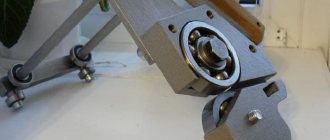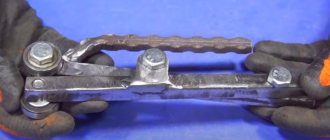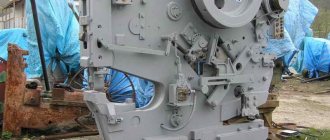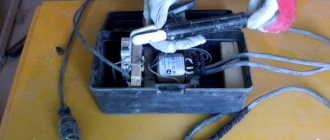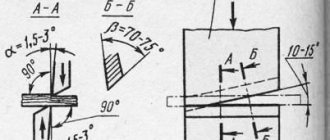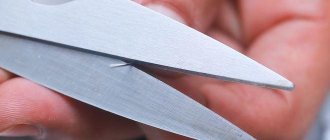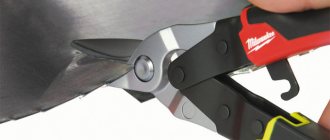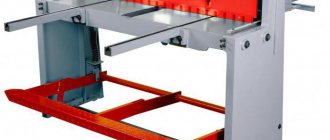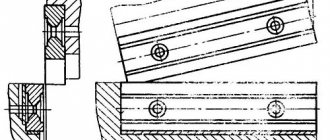Roller shears and sheet metal cutting features
In the metalworking industry, roller shears or knives are used to process sheet material. This tool is called knives because its operation is based on the use of two cutting discs. The cutting process is based on the fact that rollers are pressed into the sheet material from two sides - top and bottom. In this case, it is cut without the use of any sharp knives. The role of cutting and sharp knives is played by rollers, which touch the walls to each other on both sides.
Rollers not only cut sheet material, but also facilitate the process of moving the tool along the surface of the sheet. This means that cutting with a roller knife is not only convenient, but also effective. If we compare the operation of the device with hand scissors, the following advantages should be noted:
- Speed - cutting a sheet of steel with roller shears can be done in a matter of seconds, but using scissors requires a lot of time, which depends on the length of the material being cut
- Cut quality - the roller knife cuts not only quickly, but also with high quality. There are no chips, bends, bends, etc. at the site of the cut
- Physical fatigue - cutting with hand scissors requires physical effort, while using a roller tool eliminates this need. To cut, you only need to move the roller shears along the guides, thereby cutting the steel sheet
Roller shears are classified according to the types of knives into three types:
- They are located in parallel. The most popular type of cutting tool, which is intended exclusively for cutting material into strips, that is, cutting is performed in a straight direction
- They have one slope. They are intended for cutting not only even strips of sheet material, but also for cutting round and ring-type workpieces
- With several slopes. Such roller devices are intended directly for cutting workpieces of various shapes - ring, round, curved, etc.
After cutting, the edge of the material does not need additional processing, as it turns out smooth, without chips or burrs.
How to cut sheet metal at home
In industry, roller shears are used to cut factory-produced sheet metal. Their distinctive features are high accuracy, long service life, and the absence of the need to make them yourself. Often in the household there is a need to obtain even strips of sheet steel, which are used for various purposes. If you need one strip, then there is no need to buy or make such a device, since you can use ordinary metal scissors. If you need to cut the entire sheet or carry out cutting work regularly, then it is imperative to acquire a roller knife.
There is no justifiable sense in buying such a factory-made device, since the price ranges from 15 thousand rubles or more, which depends on the design, size and quality of the device. Roller shears for cutting sheet metal can be made with your own hands at home, using available consumables for manufacturing. Although this method requires time, it allows you to save money, resulting in a universal cutting tool for cutting sheets of stainless steel, galvanized steel, etc.
This is interesting!
It should be noted that roller shears are only suitable for cutting flat sheets, and they cannot be used to cut sheets with protrusions and recesses, for example, corrugated sheets in the transverse direction.
Manufacturing instructions
Factory models of cutters sold in stores, even in standard configuration, will cost a large amount. The price of models offered on the market starts from 20,000 rubles. Such conditions are not beneficial for purchasing a tool for home use or a small workshop, and it will be used extremely rarely.
To begin with, the main body of the instrument is designed, which everyone chooses for themselves. The main attribute of the machine is manufactured - a roller knife for sheet metal. The material from which the part is made directly affects the durability and performance of the unit. As mentioned above, the strength characteristics should be significantly higher than the similar characteristics of the material being cut. Otherwise, the minimum problem will be a low-quality cut, forcing the craftsman to clean and process the edges of each cut piece.
Scheme for assembling a roller knife
Do-it-yourself roller metal shears are mostly made from bearings. Sharpening the ends of the part forms the cutting surfaces. The main roller, connected to the drive, is attached directly to the handle. The lower one is installed on the fixed lower part of the machine. If you have skills in processing iron alloys, manufacturing such a device will take a maximum of a little more than a week, including setting up the unit.
Features of making a tool yourself
If you are tired of cutting sheet metal with scissors or a grinder, then a roller cutter is an excellent alternative to replace these tools. The advantages of this device include quiet operation and lack of energy consumption. In addition, having such a device in your home arsenal, you can even make money when your neighbors need to cut sheet metal material.
The purchase of a tool is justified only in one case, when it is necessary to perform work in large quantities. And even in this case, you can make the device yourself to use it for professional purposes. There are many designs for the devices in question, so making a device yourself is not at all difficult if you understand the principle of operation of the device.
When making a homemade tool, the following properties must be taken into account:
- Cutting knives - there should be two of them, one located on top and the other on the bottom. Knives must be made of high-quality alloy, which has a strength higher than the materials being cut. Bearings that fully meet the described requirements are used as knives.
- Base - simultaneously acts as a surface on which the steel sheet is located, as well as a guide for moving the roller shears when cutting the sheet or cutting strips
- Body of the device - for manufacturing, a steel angle with a thickness of 3 mm and a wall size of 40-60 mm is usually used
- Auxiliary tools - they are designed to secure the sheet material to the table surface while cutting it
This is interesting!
The service life of homemade roller knives is quite high, and is almost equal to that of factory models.
The service life of factory devices is at least 25 km, but provided that the thickness of the cut steel does not exceed 0.5 mm. The thicker the steel, the shorter the service life of the tool. The service life of a homemade device is influenced by such an indicator as the quality of its manufacture. Moreover, this even applies to the quality of bearings, so if you get down to business, you will need an appropriate approach.
Selection principle
Scissors are selected according to the job they are supposed to do. To quickly cut sheets up to 1 mm thick along a straight line, a tool with one movable roller is sufficient.
To cut smooth lines, work with rolled material up to 1.6 mm, and cut without a special plate with clamps, models with 2 rotating disks are suitable.
A roller with beveled surfaces and a cutting edge with an angle of 82–75⁰ is suitable for trimming the edges of stamped sheet parts, straight and shaped cutting of sheets up to 2 mm. Knives sharpened at an angle on both surfaces reduce the force applied to the device for operation. They allow you to trim off excess metal on parts located in different planes.
When purchasing a tool, you need to pay attention to the following factors:
- base and body material;
- the presence of a handle and its convenience;
- a method for adjusting the gap between disks;
- possibility of dismantling rollers for regrinding and replacement.
The durable metal frame of the structure guarantees its durability. With a comfortable handle you can work for a long time, with heavy loads. During operation, the discs can be sharpened several times.
Advantages and disadvantages
Advantages:
- safe work;
- small size, weight;
- high performance;
- simple device;
- smooth cut edge;
- ease of setup;
- the ability to cut sheets of non-ferrous and ferrous metal.
When cutting metal, the scissors are moved using a handle or electric motor along the line of the template or marking. Continuity of cutting increases productivity and reduces hand strain. The compact device cuts embossed sheets in any direction.
The design of the device is simple. You can easily make it yourself. Settings can be changed by turning just one screw. As a result, all materials are cut, including tough copper and brittle aluminum.
Flaws:
- the thickness of the sheet being cut is limited;
- with a fixed roller they cut only in a straight line;
- models with 2 rotating knives cannot cut small radii;
- When cutting holes, they need a cutting point - a small hole from which to start working.
The tool is used in large production. They are installed on automatic machines and CNC machines.
Manufacturers and cost
The most famous manufacturer of roller shears is Makita. It provides a large selection of models, from lightweight ones with one non-adjustable roller for sheets less than 0.5 mm, to complex multifunctional mechanisms capable of trimming edges and cutting workpieces up to 4 mm thick.
Products marked SMR are produced by the Russian company StankoPostavka. It produces industrial and manual models of shape cutting scissors.
Van Mark (USA) produces durable, comfortable circular knives. They have a metal base and a plastic bracket for fastening and control.
What to make a roller knife from
There are no difficulties with purchasing roller shears, since such a machine can be found in an online store and ordered. The only difficulty is that you will have to shell out a considerable amount of money to purchase it, which will not pay off soon if you do not use such equipment often. Making your own will not require any costs, but the biggest difficulty is choosing the necessary materials and assembling full-fledged roller shears from them.
Using a homemade machine allows you to cut the following types of materials:
- Cink Steel
- Stainless steel
- Aluminum
- Steel sheets up to 0.5 mm thick, for example, window slopes of metal-plastic windows
Bearings are used to make cutting knives. The diameter of these bearings depends on the size of the roller blade housing, but 20-30mm ball bearings are commonly used. In order for the bearings to ensure cutting of material, it is necessary to grind off their end faces, making them strictly at an angle of 90 degrees. The effectiveness of the tool depends on this.
This is interesting!
The diameter of the bearings affects the cutting speed. The larger the size of the bearings, the correspondingly higher the cutting speed.
Before you make a roller-type cutting tool, you need to understand its principle of use. The application is based on the fact that a homemade knife moves along guides. The corner part of a workbench or table is used as such guides. The sheet to be cut is placed on the surface of the table, and in order for the cut to be smooth and neat, it should be fixed in a stationary position. This can be done using two clamps and a wooden block of appropriate length. A block is placed on the sheet, and then it is fixed on both sides with clamps, thereby ensuring immobility during processing.
Purpose
In a home workshop, hand-held roller shears are used to cut thin steel sheets, galvanized sheets, and corrugated sheets. Depending on the design, the device allows you to quickly cut strips with smooth edges and cut out shaped parts with smooth contour lines.
In production, roller shears are used for additional processing of edged parts, cutting corrugated sheets during roofing work, and cutting other types of materials. The compact device does not require a special place for operation. Metal roofing material is cut according to markings in any position.
Instructions on how to make roller shears from bearings with your own hands
As already mentioned, there are many options for making a homemade roller cutting tool, but which one to choose for yourself depends not only on the capabilities, but also on the availability of the necessary consumables. If you need a simple homemade roller knife, you can make it from bearings. The manufacturing principle is simple, and first let’s figure out what tools and materials will be needed to make it:
- Two bearings 204 or 205. You can use other bearings that are available. They don't have to be the same size
- Corner 50-60 mm up to 30 cm long
- Threaded connectors, washers, nuts and other small consumables
- Steel tube from which to make a handle for roller shears
- The tools you will need are a welding machine, as well as a drill and grinder
When all the necessary materials are ready for work, you can get down to business. Instructions for making a roller knife yourself are as follows:
- First you need to prepare a corner, since it will act as a body on which additional elements will be placed
- We grind the edge of the bearings. Moreover, this must be done in such a way that the resulting edge has an acute angle. On both bearings it is necessary to “remove” the edge, since the possibility of using the roller shears for their intended purpose depends on this
- Next, you need to drill a hole in the corner and attach one bearing to it. A bolt with a countersunk head is used for fastening. A washer is also used to secure the bearing, which will ensure reliable pressure against the wall of the angle
- The bearing is attached so that its outer race protrudes 1-2 mm from above the edge of the angle. It is important to provide for the possibility of adjusting its contact with the second bearing by placing washers on the inside
- On the reverse side, when securing the bearing, it is necessary to ensure that the head of the fastening bolt is recessed into the base of the angle. This is necessary so that the homemade tool can move freely along the edge of the workbench. If you can’t drown the hat, you can make a groove for it in the workbench design, which is also quite appropriate when using homemade scissors
- The first part of the work at this stage is considered completed, so you should proceed to the manufacture of the second part. This is the handle, the second bearing, and also the sheet bender
- Using a similar corner that is 2 times shorter in length, you need to attach the second bearing to it. First, using a grinder, you need to cut the corner into the shape shown in the photo below.
- It is necessary to attach the bearing to the end part of the resulting workpiece by first drilling a hole
- Weld the corner piece to the main part as shown in the photo. It is important to take into account that the upper bearing must be in close contact with the lower bearing, and its outer race must be located at a distance of up to 1 mm from the base of the angle
- Finally, you need to attach the handle to the resulting installation so that it is convenient to work
The result is a homemade cutting tool for cutting metal sheets up to 0.5 mm thick. When using the device, it must be taken into account that it is intended exclusively for working with sheet materials. During operation, the edge of the bearings will wear out, so it is advisable to provide during manufacturing the possibility of adjusting the contact of the bearings. All the details of the manufacture and use of such a tool are in the video below.
This is interesting!
When you rotate one bearing by hand, the second should also rotate, which indicates that the homemade product was manufactured correctly.
The greater the distance between the end parts of the bearings, the lower the quality of the tool. In conclusion, as an example, it is worth giving an example of how much a factory roller blade costs, as well as what technical parameters it has. For example, consider a Trim Cutter 3017 brand machine and its technical parameters:
- Maximum sheet metal thickness - 0.7 mm
- The weight of the device is 4 kg
- Overall dimensions - 220x180x260 mm
- Cost from 25,000 rubles
Based on the above, it can be noted that making roller shears for cutting thin sheet metal with your own hands is not at all difficult. This does not require a lot of effort and consumables. With just 3-4 hours of free time, you can make a highly effective cutting tool at home. With roller shears, you don’t need to think about how to cut a metal sheet when installing window slopes or how to cut galvanized sheets into strips, since with it any similar work is carried out easily, quickly and efficiently.
Varieties
The cutting tool can be manual or electrically driven. The first cutting tools were used in home workshops, teams of roofers, and car mechanics. Electric models are installed in production.
According to the location of the cutting rollers and their mobility, scissors are distinguished:
- with fixed rollers;
- with one movable roller;
- with two rotating knives.
Models with fixed rollers are used for cutting strips in a straight line. The device moves along the ruler, or is fixed motionless and the sheet is pulled through it. Cutting is limited to sheet thickness up to 0.7 mm.
Using tools for cutting sheets with an upper rotating roller, the worker spends 20–30% less effort. The metal slides along the lower support under the rotating round knife. In addition to straight strips, scissors can cut sheets in an arc with a radius of more than 1 m.
Two rotating knives with bevels along the planes forming the cutting edge are capable of cutting complex shaped parts and cutting profiled sheets. The minimum turning radius of models is from 50 mm. Scissors with movable rollers glide easily over metal, cutting it. By running rollers along the markings, complex-shaped workpieces are obtained. For the production of large batches, a template is used.
Scissors with one movable roller
